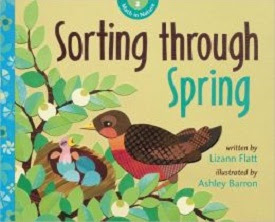Plenty of Patterns: Sorting Through Spring by Lizann Flatt
COULD FLOWERS ONLY GROW
IN SET PATTERNS, ROW BY ROW?
Which rows make an ABA, ABA pattern?
What other patterns do you see?
Patterns do occur in nature, but most of the patterns in LizAnn Flatt's new Sorting Through Spring (Math in Nature)
With the exception of the spring ritual of the male prairie hen--woo-woo flap, stampity stomp-stomp!--most of the double-page spreads simply use spring cycles to teach the concept of sorting, a math skill that involves recognizing similarities and differences and spotting repetitions, or patterns, of like and unlike. Some concepts may require previous learning, such as what an ABA pattern is.
Examples range from the simple--recognizing the color pattern in piles of shed yellow or white caribou antlers--to the advanced, calculating the ratio between the number of eggs laid by robins as opposed to hummingbirds (robins lay four; hummingbirds lay two). Many of the tasks involve skills in between, such as greater than or less than or reading a bar graph about where mosquitoes lay eggs and interpreting where in the illustrations the mosquitoes will leave their eggs. Some pattern pages are open-ended, asking what other ways the items could be grouped, by color or shape or pattern.
One double-page spread deals with reasoning as well as probability, or at least thinking beyond the counting box, asking whether a father fox is most likely to bring home a dinner of voles, squirrels, or rabbits, a query which lends itself to considerations beyond which one of the three animals are most plentiful on the page. (For example, squirrels on a tree trunk are unlikely catches for a ground-based predator, no matter how many there are!)
An appendix, "Nature Notes," offers short summaries of the spring habits and behaviors of the featured animals, but provide few clues to the mathematical queries in the text. The second in the Math in Nature series, Sorting Through Spring (Math in Nature),
My review of the first book in this series, Counting on Fall (Math in Nature)
Labels: Mathematics, Nature Study, Spring (Grades K-3)



0 Comments:
Post a Comment
<< Home